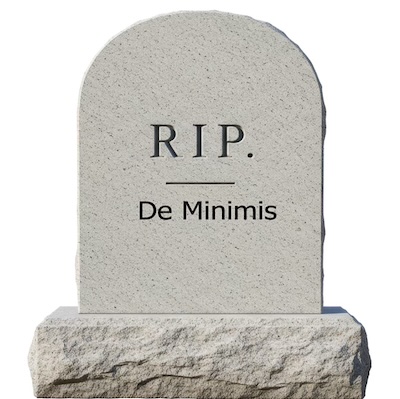By Bruce Leeds, Senior Counsel, Braumiller Law Group
Prior to August 29 of this year, 19 USC 321 – popularly known as a Section or de minimis clearance – allowed imported shipments valued at less than $800 to enter the US free of duty and entry requirements. The idea behind this was (1) the cost of processing an entry and duty payment would be more than the duty collected, and (2) setting the threshold at this level would promote eCommerce. It would also allow US Customs & Border Protection (CBP) to use its resources more effectively.
That started out just fine but soon became a monster. The boom in eCommerce and small package shippers took advantage of Section clearances under the $800 de minimis threshold. In 2015 – the year the $800 de minimis limit went into effect – there were 134 million small package shipments. By 2024 the number was 1.36 billion. Further, small packages under $800 in value did not need to satisfy other US sanctions and requirements, such as other agency restrictions, dumping duties, quotas, forced labor restrictions and country of origin marking. It was also suspected that some small packages contained dangerous goods, such as firearms and prohibited drugs. It was time to do something.
On July 30, 2025, the President issued an Executive Order suspending Section clearances. The effective date was Aug. 29, 2025. The Big Beautiful Bill passed by Congress made the suspension permanent. This meant the minimis threshold became $0 and Section clearances would no longer take place.
Thus, with no de minimis exception, all packages entering the US are now subject to entry requirements and duty payment.
There is an exception to this for bona fide gifts. Gifts having a value of less than $100 can enter without duty or entry requirements. To best use this exception the packages should be clearly labeled “gift” in English. There are severe penalties for persons fraudulently using this exception.
The effect of these changes on small package shipments was dramatic. Some countries paused shipments to adjust to the new rules and give shippers an opportunity to decide whether or not to export to the US. International postal traffic to the US decreased by 80%. Small package shippers, such as FedEx, UPS and DHL put new mechanisms in place to handle the new requirements.
Small package shipments will now be subject to formal or informal entry and duty payment. The duty payable will be the IEEPA (International Emergency Economic Powers Act) tariffs for the commodity and country of origin. For the first 6 months, shipments coming by international mail will take a duty of $80, $160 or $200 per item depending on the IEEPA tariff applicable to the item. Alternatively, the postal shipment can just take the regular IEEPA tariff. CBP is also designating certain parties to handle the clearance of postal shipments.
It is assumed that CBP will enforce other requirements for small package shipments under $800. These would include country of origin marking, quotas, dumping duties, and forced labor restrictions. Prohibited articles will be subject to seizure. The Food & Drug Administration has stated that its requirements will apply to all imports regardless of value. Other US Government agencies will need to decide if their requirements are to extend to all imports. A safe assumption is that they will.
One of the original intentions of the de minimis rule was to allow CBP to use its resources in a productive way. CBP should be concentrating its resources on collecting the duty and enforcing the regulatory requirements on large, valuable shipments. Is CBP going to require an entry and collect duty on a $25 parcel? That remains to be seen – we will see how it plays out.

